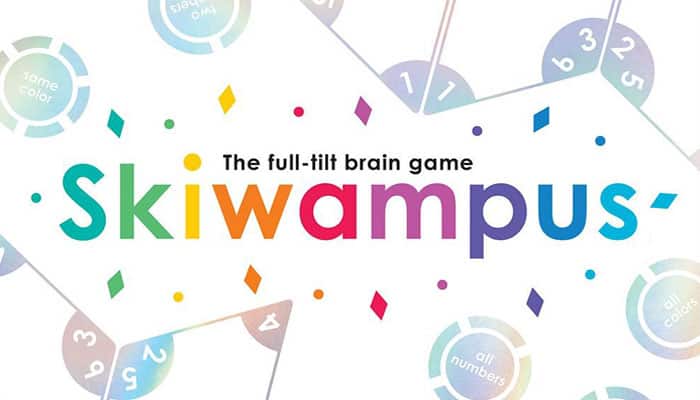

Components
- 72 diamond-shaped tiles
- 45 challenge chips
- Instructions
Object of the Game
Score the most points over three rounds by quickly arranging your tiles to form patterns that match a series of challenge chips.
Setup
Shuffle and deal each player a stack of 12 tiles. Note that each tile has a mix of four colors and six numbers in the corners.
Turn all the challenge chips face down and mix them. Then place three chips per player face-up in the center of the playing area. (Stack the rest off to the side for future rounds).
Take a moment to become familiar with the various challenges written on the chips in the center.
Remember: > means greater-than, and < means less-than.
Also note that each chip is worth a different number of points, based on the difficulty of achieving the associated challenge. The point value is indicated by the number of pips around the outer ring.

Game Play
A game of Skiwampus is played over three rounds. To begin a round, someone should say "Go!"
At that point, all players grab their tiles and simultaneously race to arrange them face up on the playing surface in front of them in such a way that the numbers and/or colors in the corners connect to form complete circles that fit a challenge shown on a chip.
Once you achieve a challenge, immediately take that chip from the center and place it over the circle that was formed by the adjacent tiles.
Any players that were competing for that challenge must move on to another chip. Then try to achieve another challenge using the rest of your tiles.
Notes
All of your tiles must form one continuous group. You may not separate them into different groups.
Once you place a chip, it "locks" the associated tiles in place for the round. You may not pick up those tiles but you can build off the other sides of those tiles.
Each circle may only be used to achieve one challenge at a time.

Ending a Round
Play continues until either all of the challenge chips have been claimed from the center or until all but one player has locked all 12 of their tiles.
Then check the tiles of the player to your right to make sure that all of the chips have been properly placed. (Place any incorrect chips back in the center). Each player should collect their claimed chips and stack them off to their side.
Set up for the next round by placing another set of challenge chips (3 per person) face up in the center.
Also, gather your tiles and pass them to the player on your left. When everyone is ready, start a new round, which plays out just like the previous.
End of the Game
At the end of three rounds, all players tally the pips on their challenge chips. Whoever has the highest total wins.
In case of a tie, whoever collected more chips wins.

Variations
Dueling Stacks: For a less intense game, instead of playing with a community group of challenge chips, each player takes a personal stack of five chips and players simultaneously try to achieve their own challenges.
Solitaire Challenge: Deal yourself 12 tiles, and then see how many challenge chips you can claim.
3 = good, 4 = excellent, 6 = amazing, 7 = expert.
Skiwampus Strut: This game is not a race. Instead, all players take turns playing off an expanding grid of tiles, with the goal to be the first to play all of their challenge chips.
Setup: Each player should take one challenge chip of each color (six total), along with three tiles. (Look at your chips and tiles but keep them secret from opponents).
Stack the rest of the tiles in several face-down piles around the perimeter of the playing area. (Place any unused challenge chips out of play).
Turn one tile face up in the center of the playing area to start the grid.
Play: Starting with the youngest player and moving to the left, take turns playing a tile to the grid and then drawing back up to three tiles.
If, at any time, (your turn or another player's), a circle is formed that matches a challenge on one of your chips, you may immediately play it to the grid.
Note: if more than one player has the same challenge chip, or multiple chips that match a circle, first preference goes to the current active player.
Draw back up to three tiles to end your turn
Win: First player to play all of their chips wins.
Continue Reading
